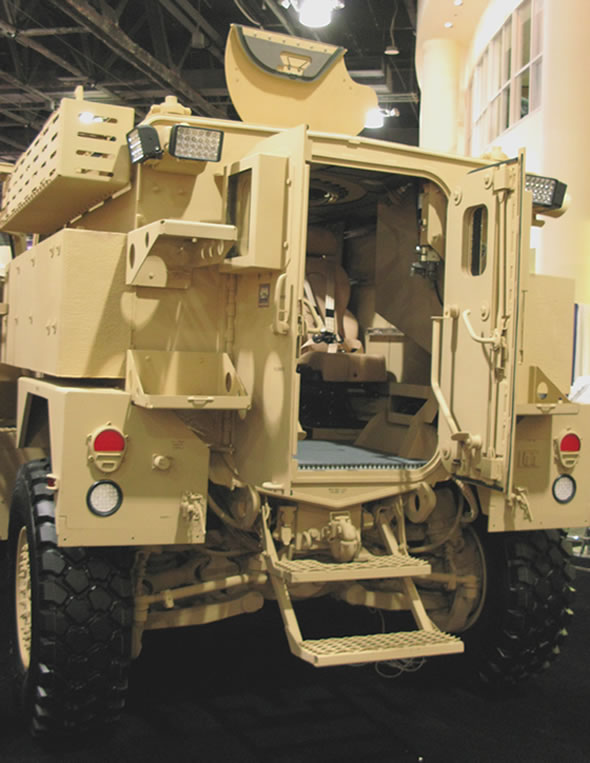

The Cougar Mine Resistant Ambush Protected (MRAP) will be modified with an independent suspension kit, improving its all-terrain mobility. The company is testing different independent suspension systems from AxleTech and Oshkosh, The later is the TAK-4 system derived from the US Marine Corps’ Medium Tactical Vehicle Replacement (MTVR) chassis, of which over 10,000 are operated by the U.S. Marine Corps. AxleTech is offering its 5000 series independent axle system, rated 12 ton (25,000 pounds) per axle.
According to Marine Corps Commandant General James T. Conway, these modifications will make MRAP vehicles already used by the Marines in Iraq more suitable for their missions in Afghanistan and more suitable for long service life. Oshkosh was awarded the initial order. AxleTech and Oshkosh are currently competing to supply follow-on orders to equip more US Marine Corps’ Cougars.
The Cougar will be the first MRAP to utilize the patented TAK-4. The MRAP Joint Program Office (JPO) recently completed testing of the system confirming its suitability for the Cougar MRAP. Based on these automotive field tests Oshkosh and FPI developed a field installable upgrade kit for the Cougar. Oshkosh will now supply those kits for 4×4 and 6×6 axle configuration vehicles under a $158 million order awarded by the MRAO JPO. The modifications are expected to be completed by the end of 2009. Testing of other MRAP models continue at the Nevada Automotive Test Center (NATC) after the MRAP JPO determined the enhancement significantly improved the vehicle’s all-terrain mobility.
“The TAK-4 has undergone more than 400,000 miles of government durability testing and will significantly improve the off-road mobility of MRAP vehicles.” said Robert Bohn, Oshkosh Corporation chairman and chief executive officer. The Independent Suspension Cougar was unveiled at the AUSA Winter exhibition earlier this year. This vehicle was initially considered by Force Dynamics for the MRAP-All Terrain Vehicle but as it’s weight was slightly above the M-ATV limit, the team decided to submit the Cheetah instead. Unlike the MRAP, which is too high to fit into the C-130 cargo bay, FPI claims a single 4×4 Cougar IS can be carried in the C-130 at Gross Vehicle Weight. FPI and AXleTech are cooperating to optimize the ISAS to become ‘blast resistant’. AxleTech independent suspension axles have already been integrated in the Australian Thales Bushmaster mine protected vehicle and Textron Systems’ M-1117 Armored Security (ASV) vehicles. The independent suspension allows for independent vertical wheel travel of up to 16 inches (40cm), facilitating more effective off-road mobility and safety.
Marine Corps Commandant General James T. Conway confirmed the corps is planning to upgrade its existing MRAPs to become more suitable for off-road mobility. The modification included the introduction of specially designed independent suspension modified to better deflect mine blast underneath the vehicle, without degrading the vehicle’s V-shaped profile. The bottom of the vehicle has also been modified adding reinforced blast surface underneath, retaining the blast-deflecting design. “The USMC doesn’t need more MRAPS.” Said General Conway. “We want to modify those we have, primarily CAT-I vehicles [the Cougar 4×4 MRAP]”. Modifications kits will be shipped to field units to upgrade CAT-I MRAP in theater. “They will get to the field faster, revolutionize MRAP use in the field, and cost less” Said General Conway. General Conway said that the US Marine Corps has enough MRAPs and is unlikely to buy the M-ATV being evaluated by the U.S. Army. The corps is also critical about the weight growth of the JLTV. According to General Conway, industry hasn’t met the US Marine Corps vision with the current designs. He said the USMC won’t buy a 20,000 pounds JLTV that can’t be airlifted by the corps helicopter.



















